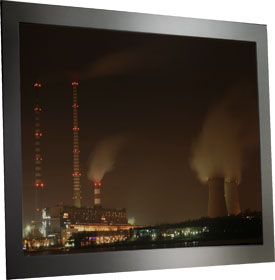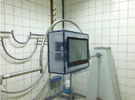

Introduction
With the thousands of different monitors available on the market today, you might wonder why industrial users can’t find a suitable monitor for their industrial applications. The reason is simple: The vast majority of these different monitors are designed for commercial uses and consequently cannot stand up to the harsh environmental conditions characteristic of industrial applications.
Unlike commercial monitors, rugged monitors are designed especially for mission-critical applications, such as marine, factory automation, railway, smart grid, and oil and gas. But how do you know that a particular product is suitable for a particular application? The answer is by verifying that the product has passed rigid operational standards that apply specifically to that application. Important standards include DNV for marine, ATEX for oil and gas and EN 50155 for railway.
The purpose of this white paper is to provide insight into what is required to design rugged monitors, with particular emphasis on what design features make a monitor suitable for harsh environmental conditions.
Rugged technology
Industrial-grade, or more informally, ‘rugged’ products are those that can withstand the rigors of harsh operational conditions. To achieve this, design engineers must concentrate on the following four important aspects of the product’s design and verification process:
• Mechanical design.
• Environmental testing.
• Choice of components and material.
• Electromagnetic protection.

A good mechanical design enhances a monitor’s durability
Like a professional boxer getting ready for the big fight, an industrial monitor must be able to take a good punch. In this case, the punch could include random vibrations caused by machinery or vehicles passing nearby and shock resulting from unexpected, sudden changes in motion. In fact, for industrial applications, the incessant vibrations experienced can be a major cause of failure. Since industrial monitors could be used in any number of scenarios, including offshore oil drilling, on ocean-going vessels, railways, automobiles and power stations, users need to ensure that the industrial monitor manufacturer has designed for – and just as importantly tested for – both vibration and shock.
Rugged, industrial monitors are typically designed with an aluminium die-cast housing, since this choice comes with a long list of plusses, not least of which is aluminium's ability to retain its strength at the high operating temperatures that industrial monitors must contend with. In addition, aluminium is lightweight, is resistive to corrosion, and has excellent electrical and thermal conductance properties.
Whereas being ‘fanless’ may be the bane of entertainers the world over, it is a key requirement for industrial products in general and industrial monitors in particular. We all know that electric currents produce heat, and consequently all electrically powered devices have the potential to get hot. This is particularly true of industrial products since the products often come with a solid, rigid exterior to protect the internal components from the elements. The problem with fans, however, is that regardless of how big or small they are, they’re always rotating to move cool air from outside the product’s housing to the interior to push the hot air out, and consequently, fans are subject to the wear and tear that comes from that rotational motion. But fans are prone to failure, which could at best cause operational delays, and at worst result in the destruction of your device. Consequently, industrial products are often required to rely solely on non-motive heat dissipation techniques to increase the product’s lifespan.
One requirement for industrial monitors that you should not overlook is how the monitors will be mounted. The fact that you are limiting your selection to fanless monitors provides a certain amount of flexibility in this regard, since you won’t need to worry about airflow, changing fan filters, and related maintenance tasks. However, before deciding on a particular monitor, make sure it supports a mounting option that is safe and convenient for your application.
Environmental testing to verify a monitor’s reliability
Being industrial often means being dusty, humid, and outright wet, and consequently industrial products must be designed to work reliably even when frequently exposed to such conditions. Although for human beings dusty conditions can be coped with fairly easily by wearing the proper protective gear, for electronic equipment a little dust on the circuit board might result in a shutdown due to a short circuit, or in the worst case scenario, cause the equipment to overheat and catch fire.
Exposure to water is another issue that industrial monitors must contend with. Regardless of the source of the water (rain, seawater, or other liquids), all water contains certain concentrations of salt or other minerals, which when wet make excellent conductors. If only a few drops of water are able to seep into the interior of the monitor and the water comes in contact with an internal circuit board, the result could be disastrous.
Since water and dust protection are critical features for so many applications, the industry recognises a standardised rating system for the level of protection offered by a device. The Ingress Protection (IP) rating uses a two digit code to indicate how well a device is protected from solid objects and water. It is represented by IPxx, where the first x indicates the protection level against solid objects, and the second x refers to the protection level against liquids. For standard industrial-grade devices, the minimum recommended rating is IP30, which would mean protection against items over 2,5 mm in diameter. For the most demanding industrial applications, an IP68 rating would provide the best protection against dust and water. A good middle of the road value is IP54, which is often used to define what it means for a product to be ‘fully rugged’.
Although some industrial applications may be mostly cold, mostly hot, or mostly somewhere in between, it is common practice to design products that provide reliable, long-term operation in a wide range of temperatures. For example, imagine for a minute what it would be like for an Ethernet switch or embedded computer sitting inside a roadside cabinet in the middle of Iowa, where it is freezing cold in the winter and blisteringly hot in the summer. In this case, a reasonable ‘safe’ operating temperature range for such products might be -40 to 70°C. To give you an idea of what kind of technological know-how is required to guarantee such an all-encompassing temperature range, some brands of embedded computers advertised as being ‘industrial’ only support an operating temperature range of 0 to 60°C.
Designing industrial monitors that can tolerate a wide temperature range presents an even greater challenge for manufacturers, since freezing cold temperature can cause white spots and LCD motion blur, and corrupt the output of onboard components in unpredictable ways. On the other side of the cold/hot spectrum, high temperatures can cause an LCD to turn dark because of the nature of the liquid crystal display. In fact, for most monitors, display stability cannot be guaranteed unless the average temperature stays between 0 and 50C. Consequently, monitors guaranteed to operate normally at an expanded temperature range, for example, between -15 and 55°C, give industrial operators a safer solution for many industrial environments.
For industrial monitors, another (and perhaps more critical) issue is that the user must be able to see clearly what’s displayed on the monitor, even when viewing it in direct sunlight or under the glare of intense industrial lighting. At first hearing, this may seem somewhat nitpicky, but in fact, how many nits (a unit of measurement associated with luminance) the monitor can generate is exactly what we need to pick at. First, something you’re familiar with: Some of the top smartphones available on the market today brag at being able to generate upwards of 700 nits. That’s pretty darn bright alright, but some industrial applications, particularly those that must operate without a hitch on bright, sunshiny days, could require a monitor that can produce between 1000 and 1300 nits.
Electromagnetic protection reduces the influence of EMI both on and from nearby equipment
As you might recall from basic physics, electric currents give rise to electromagnetic waves that radiate outwards from the conductor. In fact, for an industrial monitor, EMI is a two-way street. That is, the monitor must not be susceptible to EMI produced by nearby equipment, and the monitor itself must not produce EMI that influences nearby devices. Industrial monitors use special shielding and implement clever techniques of isolating the internal electronics of the monitor to achieve the required level of isolation.
Moxa’s rugged monitor solutions
Moxa’s rugged monitors combine the critical features needed to ensure the durability and reliability of the monitors when they are used for industrial applications. ‘Critical features’ in this case refers to every part of the monitor, including the exterior housing, all of the internal components, and of course the focal point of the monitor, the screen. As a result, Moxa’s rugged monitors have a full range of features needed for successful, long-term use in industrial environments:
• Flat panel mounting with IP54 ingress protection rating.
• Rugged aluminum housing.
• Projected capacitive multi-touchscreen technology.
• Wide operating temperature range.
• Brightness that exceeds 1000 nits.
• High resolution.
• Easily readable outdoors in direct sunlight.
The bottom line is that Moxa’s rugged monitors are designed to operate reliably in a wide range of harsh environmental conditions, including environments that are subject to strong vibrations, extreme temperatures and wet or dusty conditions.
| Tel: | +27 11 781 0777 |
| Email: | info@rjconnect.co.za |
| www: | www.rjconnect.co.za |
| Articles: | More information and articles about RJ Connect |
© Technews Publishing (Pty) Ltd | All Rights Reserved